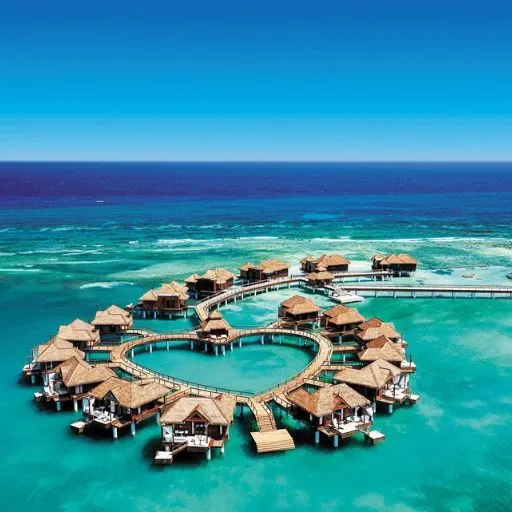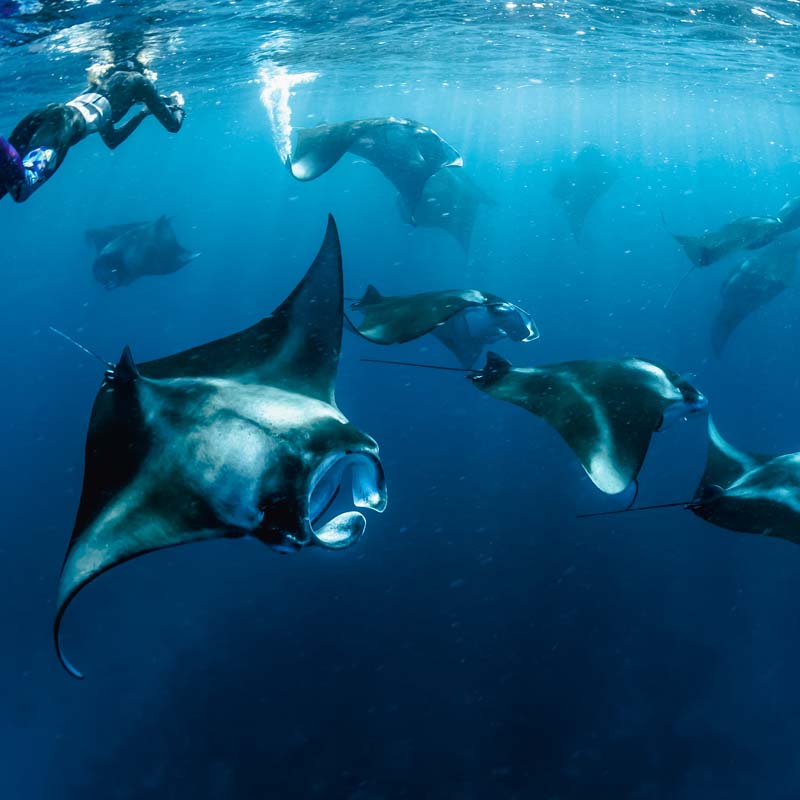Manta Ray watching in the Maldives is one of the most famous activities to enjoy in this beautiful destination. Hundreds of travellers from around the world visit the Maldives for years to experience this one-of-a-kind activity. But if you want to spot these incredible sea creatures you need to make sure to visit the Maldives in the right season. In this article, we share all about Manta Ray in the Maldives.
Manta Ray and their Significance
Hailing from the same family as that of sharks, the Manta Rays have been surfing the deep waters of the earth for over 5 million years! They are easily recognizable due to their oddly flattened body structure and are classified as the largest rays in the world.
The Manta rays have wing spans stretching 29 feet in length and weigh nearly 2.5 tons. What makes them truly one of a kind is the fact that they have the largest brains of any fish studies so far. A brain so far off of its peers that they have the ability to learn, exercise their memory, distinguish between objects, and recognize themselves in the mirror!
Manta Rays are more commonly referred to as Devil’s Fish although there is nothing evil about them. The nickname comes with the two horn-shaped cephalic fins, giving them an evil appearance. Despite being quite a significant creature of the deep blue oceans of the Earth, their existence isn’t quite so. Manta Rays are labelled as an endangered species, and like all endangered species – their biggest threat is human activity.
Maldives Manta Ray Season
The greatest disappointment would be coming to Maldives for an amazing snorkeling and diving experience but finding out the Manta Ray has gone on vacation to the unknowns! Why isn’t the Manta Ray in the vicinity of your island’s diving spots? When will it be around so that you could take a good ‘bucket-list’ worthy picture alongside the devil fish?
Well firstly, the Maldives is the Manta Ray’s holiday destination, alongside many other diverse arrays of sea creatures, and it is no surprise. Your diving experience in the Maldives is one to be immersed in swarms of fish of multiple species. However, for Manta Ray spotting there’s two monsoon seasons that you might want to keep an eye out for.
The first monsoon is the southwestern monsoon that spans between the months of May to October. In this season, the ocean currents encourage upwelling which leads to a drastic increase in zooplankton at the eastern atolls. Having a rich source of its favourite seafood, the Manta Ray makes its way to the eastern atolls alongside a wide variety of other species as the site hosts a healthy food chain.
The second monsoon is the northeastern monsoon which spans from December all the way to March and changes the direction of currents. In this case, the Manta Rays may roam around the western outskirts of the atolls with the switch in its nutrition source.
In conclusion – if you plan to vacate during the months of May to October you might want to head out to the eastern atolls to spot Manta Rays. For a tour that’s happening during the months of December to March, you might want to head out to the western outskirts of the atolls.
Best Manta Ray Spots in the Maldives
Baa Atoll
Hanifaru Bay in Baa Atoll is the only Maldivian UNESCO Biosphere Reserve and the best place to spot the Manta Ray. During the Southwest monsoon, the vicinity of the Baa atoll attracts rich concentrations of plankton, further enhanced by the moon’s changing phases. This steep concentration in plankton attracts not just Manta Rays but also whale sharks alongside them that you could snorkel with.
Addu (Seenu) Atoll
The furthest southwardly atoll in the Maldives is famous for being one of the best scuba diving locations and heart-shaped region on the map. It is one of the only locations in the Maldives where Mantas of wingspans over 16 feet in length are said to take refuge under. To an all-year-round Manta ray spotting possibility, you would want to make your way over towards Addu Atoll.
South Ari (Alifu Dhaalu)
Despite being a limited time only Mantra spotting location, the South Ari is yet another top spot for Mantra Ray spotting. The best time of the year to spot Mantra rays in South Ari is between the moths of October to May during the northeastern monsoon. The Mantra spotting frequency would reach a peak between the months of February to April during this monsoon season.
Best Resorts to Swim Besides the Devil Fish
Do you want to swim beside the one-of-a-kind Manta Rays and share your experience swimming alongside it for the rest of the world to see? In that case you might want to check out the list of resorts with eye-candy sites, tranquil vibes, and scintillating views surrounded by turquoise waters – and Manta Rays! Whether you are touring alongside your loved one or your family for a lovely vacation, these resorts will never disappoint you
Here are some accommodation options to choose from when you want to go on your Manta Ray watching adventure.
Baa Atoll
Kiha Beach (Booking.com 8.9)
Dusit Thani Maldives (Booking.com 9.2)
Amilla Maldives Resort & Residencies (Booking.com 9.3)
Anantara Kihavah Maldives Villas (Booking.com 9.4)
South Ari
Radisson Blu Resort Maldives (Booking.com 8.6)
The Residence Maldives at Dhigurah (Booking.com 9.0)
Sun Island Resort & Spa (Booking.com 9.0)
LUX South Ari Atolls (Booking.com 9.2)
Vilamendhoo Island Resort & Spa (Booking.com 9.4)
Outrigger Maldives Maafushivaru Resort (Booking.com 9.4)
Like to enjoy Manta Rays in the Maldives. Let us help you plan your tour! From accommodation to transportation we will plan it all so all you have to do is pack your bag for this existing you. Get in touch with us for more details
Photo by Sebastian Pena Lambarri on Unsplash






